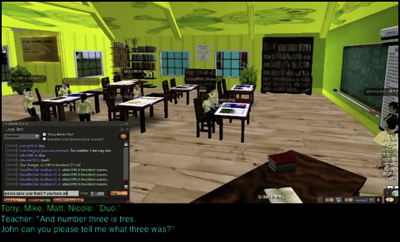
VirtualPREX
Virtual Professional Experience
Innovative assessment using a 3D virtual world with
pre-service teachers
VirtualPrex is a mechanism whereby pre-service teachers can gain skills, confidence and techniques to support their real life professional experience prior to practicum by the use of virtual worlds.
About the Project
Aims
Outcomes
Phases
How to use SL and VirtualPREX tools
VirtualPREX classrooms
VirtualPREX role-plays
Machinima
Assessment
Dissemination
Contacts - Project Team
Assessment using Machinima
Introduction
Use pre-existing
Construct own
Develop rubric
Annotate
Resources
References
Sponsored by:
 Support
for this
project has been provided by the Australian Learning and Teaching
Council Ltd, an initiative of the Australian Government Department of
Education, Employment and Workplace Relations.
The views expressed in this website do not necessarily reflect the
views of the Australian Learning and Teaching Council.
Support
for this
project has been provided by the Australian Learning and Teaching
Council Ltd, an initiative of the Australian Government Department of
Education, Employment and Workplace Relations.
The views expressed in this website do not necessarily reflect the
views of the Australian Learning and Teaching Council.Suggested assessment activities using machinima
1. Using pre-existing machinima – pre-recorded role-plays
(i) Activities for using a single instance of a machinima
Instructions for teacher educators
The VirtualPREX website (http://www.virtualprex.com/machinima.html) contains example machinima that can be used for learning and assessment activities. When using machinima for assessment tasks the teacher educator can list the types of scenarios that are relevant for particular learning outcomes. For example, the pre-service teacher might be asked to look for examples of particular strategies that the teacher has used to engage students in the acquisition of knowledge and skills in a particular discipline; they may be asked to reflect on what were effective practices observed in the machinima or what appeared to be ineffective in engaging students and propose alternative strategies and practices. Observing machinima can be coupled with analysis and critique where the pre-service teacher can concentrate on aspects of behaviour management, examples of particular engagement strategies, communication skills (verbal, non-verbal, special awareness), how teachers might motivate students to stay on task.
An example of a pre-recorded machinima available for teacher educators to use is the “Counting machinima” which can be found at http://www.youtube.com/watch?v=iKXvPOa26o0&feature=youtu.be

Pre-service teachers can be asked to identify particular instances of strategies or approaches that are likely to be effective in a real classroom. For example they could be asked to observe the “Counting machinima” shown above and identify instances where the teacher used the following strategies:
• Used student’s name
• Did not yell or get annoyed
• Set expectations
• Clear, calm authoritative voice
• Picked different students each time
• Did not just concentrate on trouble makers
• Set learning outcomes
• Kept coming back to learning outcomes
• Reward for doing a task appropriately
• Reinforced good behaviours
• Instructions repeated
• Remind students of expectations
• Put pressure on student to cooperate
• Remind students how to behave in class
• Reinforcement
• Got students to listen and respond
• Got students to repeat answers
Instructions for pre-service teachers
1. Identify key strategies that were used in the role-play to engage students in the activity displayed on machinima [insert machinima title and link].
2. Using the machinima [insert machinima title and link], identify instances where the teacher demonstrated effective use of the implemented strategy.
3. Using the machinima [insert machinima title and link], identify instances where the teacher did not demonstrate effective use of the implemented strategy.
4. Using the machinima [insert machinima title and link], discuss how you could facilitate more effective use of the implemented strategy in a real classroom.
Key components for this activity:
1. View machinima first without taking any notes.
2. View machinima again, this time taking notes for selected instances of evidence for the aspects outlined in the rubric.
3. Provide an overall reflection on the approach adopted by the teacher to engage the students in productive learning and remaining on task.
4. Your educator will provide feedback on your annotations and reflections.
2. View machinima again, this time taking notes for selected instances of evidence for the aspects outlined in the rubric.
3. Provide an overall reflection on the approach adopted by the teacher to engage the students in productive learning and remaining on task.
4. Your educator will provide feedback on your annotations and reflections.
Rubric for observing key characteristics of teacher portrayed in single machinima:
| Criterion |
No evidence |
Some evidence (example) |
Extensive evidence (examples) |
| Pre-service teacher provided evidence that they could teach appropriate small group activities and lessons | |||
| Pre-service teacher provided evidence that they could establish clear and achievable learning goals for students | |||
| Pre-service teacher provided evidence that they could engage students in productive learning |
(ii) Activities for using multiple instances of machinima
Instructions for teacher educators
The VirtualPREX website (http://www.virtualprex.com/machinima.html) contains example machinima that can be used for learning and assessment activities. When using machinima for assessment tasks the teacher educator can list the types of scenarios that are relevant for particular learning outcomes. For example, the pre-service teacher might be asked to look for examples of particular strategies that the teacher has used to engage students in the acquisition of knowledge and skills in a particular discipline; they may be asked to reflect on what were effective practices observed in the machinima or what appeared to be ineffective in engaging students, and propose alternative strategies and practices. Observing multiple machinima can be coupled with comparisons where the pre-service teachers identify differences in approaches for behaviour management, compare particular engagement strategies, communication skills (verbal, non-verbal, special awareness), and compare different strategies for motivating students to stay on task.
[Refer to “(i) Activities for using a single instance of a machinima. Instructions for teacher educators” above for more details about example strategies pre-service teachers should look for in the multiple machinima]
Instructions for pre-service teachers
1. Identify key strategies that were used in the role-play to engage students in the identified activity displayed on machinima [insert machinima title and link].
2. Using the machinima [insert machinima title and link], identify instances where the teacher demonstrated effective use of the implemented strategy.
3. Using the machinima [insert machinima title and link], identify instances where the teacher did not demonstrate effective use of the implemented strategy.
4. Using the machinima [insert machinima title and link], discuss how you could facilitate more effective use of the implemented strategy in a real classroom.
Key components for this activity:
1. View each machinima first without taking any notes.
2. View each machinima again, this time taking notes for selected instances of evidence for the aspects outlined in the rubric within each machinima.
3. Provide an overall reflection on the approaches adopted by the teacher to engaging the students in productive learning and remaining on task in each machinima.
4. Your educator will provide feedback on your annotations and reflection.
2. View each machinima again, this time taking notes for selected instances of evidence for the aspects outlined in the rubric within each machinima.
3. Provide an overall reflection on the approaches adopted by the teacher to engaging the students in productive learning and remaining on task in each machinima.
4. Your educator will provide feedback on your annotations and reflection.
Rubric for observing key characteristics of teacher portrayed in multiple machinima:
| Criterion |
No evidence |
Some evidence (example) |
Extensive evidence (examples) | Comparison of effectiveness |
| machinima 1 |
machinima 1 |
machinima 1 |
||
| machinima 2 | machinima 2 | machinima 2 | ||
| Pre-service teacher provided evidence that they could teach appropriate small group activities and lessons | ||||
| Pre-service teacher provided evidence that they could establish clear and achievable learning goals for students | ||||
| Pre-service teacher provided evidence that they could engage students in productive learning | ||||




